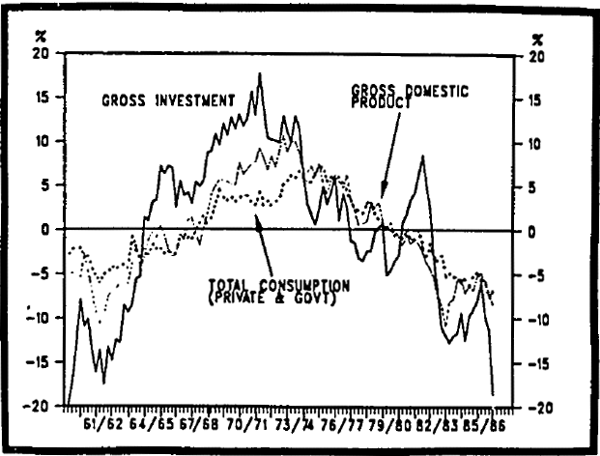RDP 8704: The Role and Consequences of Investment in Recent Australian Economic Growth 4. Investment and Fluctuations in Economic Growth
April 1987
Investment affects economic activity in the first instance through its impact on aggregate demand. Historically, investment has been the most volatile component of aggregate demand. In the past three decades, the annual growth rate of investment has fluctuated between −27 per cent and 23 per cent, compared with growth rates of GDP between −1 per cent and 8 per cent. Coefficients of variation of the growth rates for the major components of expenditure over the past two decades are shown in Table 4.1 below. As can be seen from that table, cycles in the components of investment are considerably larger than those in the other components of demand.
| Expenditure component | Coefficients of Variation |
|---|---|
| Total consumption | 1.55 |
| • Private consumption | 1.49 |
| • Government consumption | 3.52 |
| Total investment | 5.64 |
| • Dwellings | 13.35 |
| • Plant and equipment | 11.89 |
| • Construction | 16.92 |
| • Public enterprises | 13.34 |
| • General government | 8.30 |
| Exports | 7.24 |
| Imports | 11.84 |
| GDP | 2.40 |
Figure 4.1 shows the deviation of the log of some major components of spending and deviations of GDP, from their respective linear trends. This provides some idea of the contributions of these components to deviations of GDP from its trend. On average, over the whole period, gross investment has accounted for about a quarter of GDP growth per annum. However, the volatile nature of investment relative to total GDP, highlighted in Figure 4.1, is consistant with a much greater contribution from investment in some periods and less in others. As suggested by Table 4.1, fluctuations in investment spending appear to have been a major source of fluctuations in GDP.
DEVIATION FROM TREND

The extent of the influence of investment on cycles in GDP, of course, depends on the many behavioural relationships that make up the economic structure. Estimates of the impact and long-run multiplier effects of changes in exogenous demand vary widely. These multipliers apply to unexpected or exogenous shocks to components of aggregate demand. Over the past 25 years, the most obvious candidate period for an investment shock is that associated with the mineral boom in the early 1980s.
In order to calculate a very rough estimate of the impact of investment in this period, we assume that the entire deviation of business-fixed investment from its trend was in the nature of an exogenous shock and simulate its impact on GDP using the RBII model of the Australian economy.[15] Under this assumption, the cumulative shock to investment over the four-year period from March 1980 was in the order of $9 billion, in 1979/80 prices, or a little over 2 per cent of GDP in that period. This shock contributed to a cumulative increase in GDP between March 1980 and December 1985 of around $11 billion, relative to trend, implying a multiplier of about 1.2. This calculation depends, of course, on the assumption that the surge of investment in this period was entirely autonomous.
Investment has clearly played a significant short-term role in the pattern of growth of output in Australia. Deviations of investment from trend set up, through their influence on aggregate demand, corresponding deviations in GDP about trend. As previously discussed, investment also influences the trend of GDP through its effect on the capital stock and thereby on the productive capacity of the economy. In the next section, we examine some of the factors that may have influenced the amount of private sector investment undertaken in the post-war period.
Footnote
See Fahrer and Rankin (1984) for specification of the RBII model. [15]